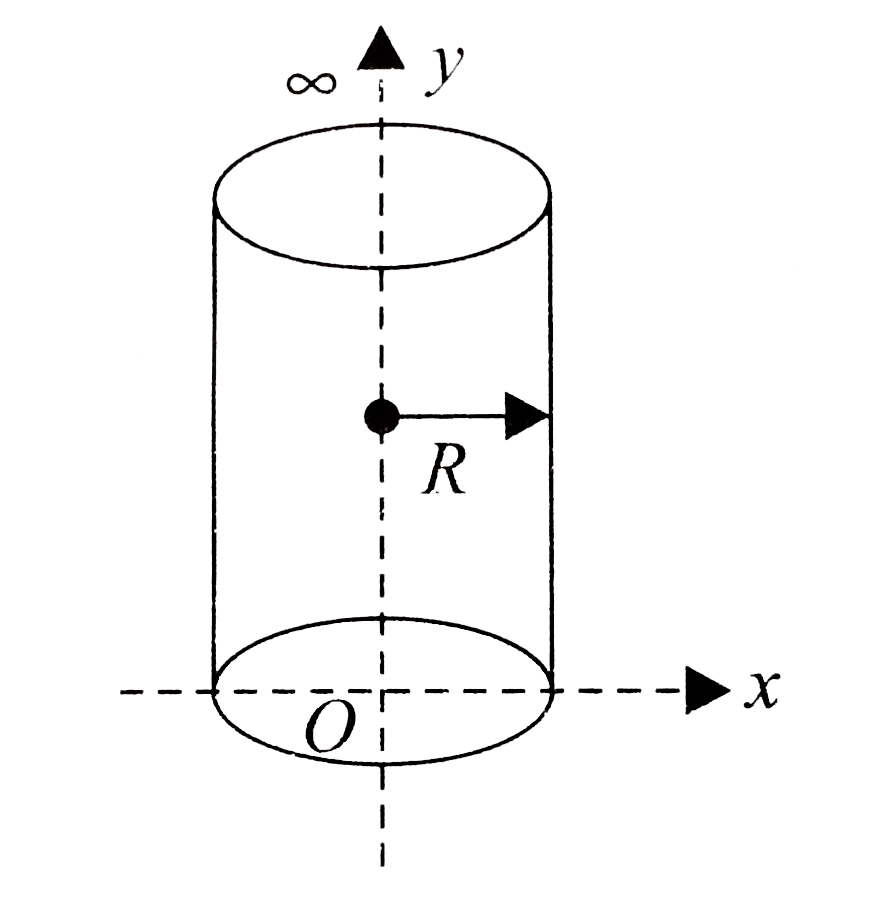What is the current in a wire of radius R = 2.67 mm if the magnitude of the current density is given by (a) Jn=J0r/Rand(b)Jb=J0(1−r/R), in which r is the radial distance and J0=5.50×104A/m2? (c) Which function maximizes the current density near the wire's surface?
The correct Answer is:(a) 0.821A; (b) 0.411 A (C) Ja has maximum value near the surface of the wire
To solve the problem, we will break it down into three parts as described in the question.
Given Data:
- Radius of the wire, R=2.67mm=2.67×10−3m
- Current density for part (a): Jn=J0rR
- Current density for part (b): Jb=J0(1−rR)
- J0=5.50×104A/m2
Part (a): Calculate the Current In
1. Expression for Current Density:
Jn=J0rR
2. Differential Area Element:
The differential area element dA in cylindrical coordinates is given by:
dA=2πrdr
3. Total Current:
The total current In can be calculated by integrating the current density over the cross-sectional area of the wire:
In=∫R0JndA=∫R0J0rR(2πrdr)
4. Substituting and Simplifying:
In=∫R0J0rR(2πrdr)=2πJ0R∫R0r2dr
The integral ∫R0r2dr=R33.
5. Final Expression for Current:
In=2πJ0R⋅R33=2πJ0R23
6. Substituting Values:
In=2π(5.50×104)(2.67×10−3)23
In=2π(5.50×104)(7.1289×10−6)3
In≈0.821A
Part (b): Calculate the Current Ib
1. Expression for Current Density:
Jb=J0(1−rR)
2. Total Current:
The total current Ib can be calculated similarly:
Ib=∫R0JbdA=∫R0J0(1−rR)(2πrdr)
3. Substituting and Simplifying:
Ib=∫R0J0(1−rR)(2πrdr)=2πJ0(∫R0rdr−1R∫R0r2dr)
The integrals yield:
∫R0rdr=R22,∫R0r2dr=R33
4. Final Expression for Current:
Ib=2πJ0(R22−1R⋅R33)=2πJ0(R22−R23)
Ib=2πJ0⋅3R2−2R26=2πJ0R26=πJ0R23
5. Substituting Values:
Ib=π(5.50×104)(2.67×10−3)23
Ib≈0.411A
Part (c): Determine Which Function Maximizes Current Density Near the Surface
- From the calculations:
- In≈0.821A
- Ib≈0.411A
Since In>Ib, the function Jn=J0rR maximizes the current density near the wire's surface.
Summary of Results:
- (a) Current In≈0.821A
- (b) Current Ib≈0.411A
- (c) The function that maximizes the current density near the wire's surface is Jn=J0rR.
- Radius of the wire, R=2.67mm=2.67×10−3m
- Current density for part (a): Jn=J0rR
- Current density for part (b): Jb=J0(1−rR)
- J0=5.50×104A/m2
Jn=J0rR
The differential area element dA in cylindrical coordinates is given by:
dA=2πrdr
The total current In can be calculated by integrating the current density over the cross-sectional area of the wire:
In=∫R0JndA=∫R0J0rR(2πrdr)
In=∫R0J0rR(2πrdr)=2πJ0R∫R0r2dr
The integral ∫R0r2dr=R33.
In=2πJ0R⋅R33=2πJ0R23
In=2π(5.50×104)(2.67×10−3)23
In=2π(5.50×104)(7.1289×10−6)3
In≈0.821A
Jb=J0(1−rR)
The total current Ib can be calculated similarly:
Ib=∫R0JbdA=∫R0J0(1−rR)(2πrdr)
Ib=∫R0J0(1−rR)(2πrdr)=2πJ0(∫R0rdr−1R∫R0r2dr)
The integrals yield:
∫R0rdr=R22,∫R0r2dr=R33
Ib=2πJ0(R22−1R⋅R33)=2πJ0(R22−R23)
Ib=2πJ0⋅3R2−2R26=2πJ0R26=πJ0R23
Ib=π(5.50×104)(2.67×10−3)23
Ib≈0.411A
- In≈0.821A
- Ib≈0.411A
- (a) Current In≈0.821A
- (b) Current Ib≈0.411A
- (c) The function that maximizes the current density near the wire's surface is Jn=J0rR.
Topper's Solved these Questions
- CURRENT AND RESISTANCEBook:RESNICK AND HALLIDAYChapter:CURRENT AND RESISTANCEExercise:Practice Questions (Single Corret Choice Type)
Explore 39 Videos
- CURRENT AND RESISTANCEBook:RESNICK AND HALLIDAYChapter:CURRENT AND RESISTANCEExercise:Practice Questions (Linked Comprehension)
Explore 5 Videos
- CURRENT AND RESISTANCEBook:RESNICK AND HALLIDAYChapter:CURRENT AND RESISTANCEExercise:Checkpoints
Explore 6 Videos
- CIRCULAR MOTIONBook:RESNICK AND HALLIDAYChapter:CIRCULAR MOTIONExercise:CHECK POINTS
Explore 6 Videos
- ELASTICITYBook:RESNICK AND HALLIDAYChapter:ELASTICITYExercise:PRACTICE QUESTIONS (Integer Type)
Explore 3 Videos
Similar Questions
A cylindrical wire if radius R = 2 mm is of uniform area of cross-section. The current density through a cross-section varies with radial distance r as J=ar2, where a=3.2×1011A/m2 and r is in metres. What is the current through the outer portion of the wire between radial distances R/2 and R?
View Solution(a) The current density in a cylindrical wire of radius R=2.0mm is uniform across a cross section of the wire and is J=2.0×105A/m2. What is the current through the outer portion of the wire between radial distances R/2 and R?
(b) Suppose, instead, the current density through a cross section varies with radial distance r as J=ar2, in which a=3.0×1011A/m4 and r is in meters. What now is the current through the same outer portion of the wire?
View Solution
Knowledge Check
The current density is a solid cylindrical wire a radius R, as a function of radial distance r is given by J(r)=J0(1−rR) . The total current in the radial regon r = 0 to r=R4 will be :
A5J0πR232B5J0πR296C3J0πR264DJ0πR3128A cylindrical wire of radius R has current density varying with distance r form its axis as J(x)=J0(1−r2R2) . The total current through the wire is
AπJ0R22B2πJ0R23C4πJ0R23Dnone of theseConsider the figure, cross-sectional area of consider at A and B is 2a and a respectively. Current density at A and B are given by JA and JB then JA/JB is
 A12B2C1D4
A12B2C1D4
A current is flowing through a cylinderical conductor of radius R, such that current density at any cross-section is given by J=J0(1−rR), where r is radial distance from axis of the cylinder .Calculate the total current through the cross-section of the conductor.
View SolutionThe current density ¯¯¯J inside a long, solid cylindrical wire of radius a=12mm is in the direction of the central axis, and its magnitude varies linearly with radial distance r from the axis according to J=J0ra, where J0=1054πA/m2. Find the magnitude of the magnetic field at r=a2 in μT
View SolutionAn infinite cylindrical wire of radius R and having current density varying with its radius r as, J=J0[1−(r/R)]. Then answer the following questions.

Magnitude of maximum magnetic field is
View SolutionAn infinite cylindrical wire of radius R and having current density varying with its radius r as, J=J0[1−(r/R)]. Then answer the following questions.

Graph between the magnetic field and radius is
View SolutionA long cylindrical conductor of radius R carries I as shown. The current density is a function of radius r as j = br, where b is a constant. The magnetic field at a distance r1(r1<R) is

View Solution